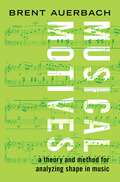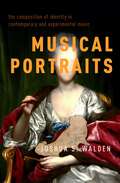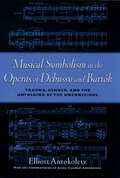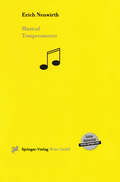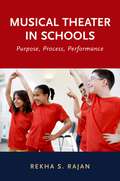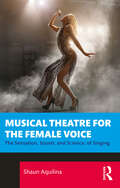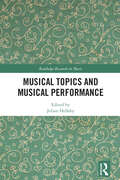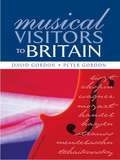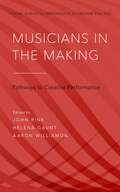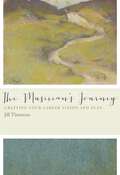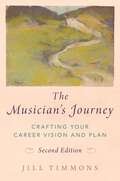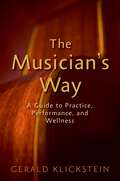- Table View
- List View
Musical Motives: A Theory and Method for Analyzing Shape in Music
by Brent AuerbachAll music fans harbor in their memories vivid fragments of their favorite works. The starting guitar solo of "Satisfaction" by the Rolling Stones, the da-da-da-DUM gesture that opens Beethoven's Fifth Symphony, the lush swelling chords of a beloved movie soundtrack: hearing the briefest snippet of any of these is enough to transport listeners into the piece's sonic and emotional world. But what makes musical motives so powerful? In Musical Motives, author Brent Auerbach looks at the ways that motives the small-scale pitch and rhythm shapes that are ever-present in music unify musical compositions and shape our experiences of them. Motives serve both to communicate basic musical meaning and to tie together sound space like the motifs in visual art. They present in all genres from classical and popular to jazz and world music, making them ideally suited for analysis. Musical Motives opens with a general introduction to these fundamental building blocks, then lays out a comprehensive theory and method to account for music's structure and drama in motivic terms. Aimed at both amateur and expert audiences, the book offers a tiered approach that progresses from Basic to Complex Motivic Analysis. The methods are illustrated by small- and large-scale analyses of pieces by Mozart, Beethoven, Handel, Chaminade, Verdi, Radiohead, and many more.
Musical Portraits: The Composition of Identity in Contemporary and Experimental Music
by Joshua S. WaldenJoshua S. Walden's Musical Portraits: The Composition of Identity in Contemporary and Experimental Music explores the wide-ranging but under-examined genre of musical portraiture. It focuses in particular on contemporary and experimental music created between 1945 and the present day, an era in which conceptions of identity have changed alongside increasing innovation in musical composition as well as in the uses of abstraction, mixed media, and other novel techniques in the field of visual portraiture. In the absence of physical likeness, an element typical of portraiture that cannot be depicted in sound, composers have experimented with methods of constructing other attributes of identity in music, such as character, biography, and profession. By studying musical portraits of painters, authors, and modern celebrities, in addition to composers' self-portraits, the book considers how representational and interpretive processes overlap and differ between music and other art forms, as well as how music is used in the depiction of human identities. Examining a range of musical portraits by composers including Peter Ablinger, Pierre Boulez, Morton Feldman, Philip Glass, György Ligeti, and Virgil Thomson, and director Robert Wilson's on-going series of video portraits of modern-day celebrities and his "portrait opera" Einstein on the Beach, Musical Portraits contributes to the study of music since 1945 through a detailed examination of contemporary understandings of music's capacity to depict identity, and of the intersections between music, literature, theater, film, and the visual arts.
Musical Portraits: The Composition of Identity in Contemporary and Experimental Music
by Joshua S. WaldenJoshua S. Walden's Musical Portraits: The Composition of Identity in Contemporary and Experimental Music explores the wide-ranging but under-examined genre of musical portraiture. It focuses in particular on contemporary and experimental music created between 1945 and the present day, an era in which conceptions of identity have changed alongside increasing innovation in musical composition as well as in the uses of abstraction, mixed media, and other novel techniques in the field of visual portraiture. In the absence of physical likeness, an element typical of portraiture that cannot be depicted in sound, composers have experimented with methods of constructing other attributes of identity in music, such as character, biography, and profession. By studying musical portraits of painters, authors, and modern celebrities, in addition to composers' self-portraits, the book considers how representational and interpretive processes overlap and differ between music and other art forms, as well as how music is used in the depiction of human identities. Examining a range of musical portraits by composers including Peter Ablinger, Pierre Boulez, Morton Feldman, Philip Glass, György Ligeti, and Virgil Thomson, and director Robert Wilson's on-going series of video portraits of modern-day celebrities and his "portrait opera" Einstein on the Beach, Musical Portraits contributes to the study of music since 1945 through a detailed examination of contemporary understandings of music's capacity to depict identity, and of the intersections between music, literature, theater, film, and the visual arts.
Musical Symbolism in the Operas of Debussy and Bartok
by Elliot AntokoletzMusical Symbolism in the Operas of Debussy and Bartók explores the means by which two early 20th century operas - Debussy's Pelléas et Mélisande (1902) and Bartók's Duke Bluebeard's Castle (1911) - transformed the harmonic structures of the traditional major/minor scale system into a new musical language. It also looks at how this language reflects the psychodramatic symbolism of the Franco-Belgian poet, Maurice Maeterlinck, and his Hungarian disciple, Béla Balázs. These two operas represent the first significant attempts to establish more profound correspondences between the symbolist dramatic conception and the new musical language. Duke Bluebeard's Castle is based almost exclusively on interactions between pentatonic/diatonic folk modalities and their more abstract symmetrical transformations (including whole-tone, octatonic, and other pitch constructions derived from the system of the interval cycles). The opposition of these two harmonic extremes serve as the basis for dramatic polarity between the characters as real-life beings and as instruments of fate. The book also explores the new musico-dramatic relations within their larger historical, social psychological, philosophical, and aesthetic contexts.
Musical Symbolism in the Operas of Debussy and Bartok
by Elliot AntokoletzMusical Symbolism in the Operas of Debussy and Bart?k explores the means by which two early 20th century operas - Debussy's Pell?as et M?lisande (1902) and Bart?k's Duke Bluebeard's Castle (1911) - transformed the harmonic structures of the traditional major/minor scale system into a new musical language. It also looks at how this language reflects the psychodramatic symbolism of the Franco-Belgian poet, Maurice Maeterlinck, and his Hungarian disciple, B?la Bal?zs. These two operas represent the first significant attempts to establish more profound correspondences between the symbolist dramatic conception and the new musical language. Duke Bluebeard's Castle is based almost exclusively on interactions between pentatonic/diatonic folk modalities and their more abstract symmetrical transformations (including whole-tone, octatonic, and other pitch constructions derived from the system of the interval cycles). The opposition of these two harmonic extremes serve as the basis for dramatic polarity between the characters as real-life beings and as instruments of fate. The book also explores the new musico-dramatic relations within their larger historical, social psychological, philosophical, and aesthetic contexts.
Musical Temperaments
by Erich NeuwirthPreface What you are now reading is the written version of an electronic document that explains the mathematical principles for different musical temperaments. The electronic version contains many music examples that you can listen to while you are working with this document at a computer. The written version obviously cannot offer this possibility. It serves therefore merely as a parallel study aid and guide and cannot replace actually working with the electronic text. Musical Temperaments Contents • V II Contents Introduction and Fundamental Properties 1 Pitch and Frequency 1 Preliminary Remarks 1 Frequencies and Intervals 2 Tuning Systems and Frequencies 5 Musical Scales in Different Tunings 5 Pure Tuning 5 Intervals and Triads in Pure Tuning 12 Pythagorean Tuning 23 Intervals and Triads in Pythagorean Tuning 31 Meantone Tuning 34 Intervals and Triads in Meantone Tuning 39 Equal Temperament (Tuning) 42 Intervals and Triads in Equal Temperament (Tuning) 47 Summary 50 Appendices 53 Pictorial explanations 53 Tables of Frequencies and Intervals 54 Operating Instructions 62 Glossary 67 Musical Temperaments Introduction and Fundamental Properties • 1 Introduction and Fundamental Properties Pitch and Frequency Preliminary Remarks It is well known that tones consist of periodically recurring phenomena, that is, beats repeating in a regular pattern. The number of repetitions of beats per second is measured in Hertz: 440 Hertz mean 440 beats per second. This number is also called the frequency of a beat.
Musical Theater in Schools: Purpose, Process, Performance
by Rekha S. RajanMusical Theater in Schools: Purpose, Process, and Performance is a comprehensive resource for general classroom teachers, music and drama educators. The book is the first of its kind to provide strategies for including musical theater across the K-12 curriculum, inviting teachers and arts specialists to utilize musical theater as an interdisciplinary art form within their own classrooms, or as collaborative projects throughout the school community. Typically relegated to after-school activities, musical theater can have a strong place both as an avenue for performance, creativity, and self-expression, or as a pathway for student learning about academic subjects. Drawing upon musical theater terminology, the book is organized into three distinct acts. The first section gives an overview of how this popular art form developed and how its stories reflect our culture and community, with descriptions of musical theater as a profession for adults, and for children. This section also discusses musical theater's compromised position within the arts, often relegated to theater departments even though repertoire and songs are available to music teachers, and argues for musicals as a form of interdisciplinary education. The second section outlines ways of integrating musical theater into the curriculum with considerations for the National Core Arts Standards. The third section provides suggestions for auditions, casting, rehearsing, and presenting a complete production, with a specific focus on student-centered performances. Based on the author's own experiences as a professional musical theater performer, coupled with teaching and research in classroom settings, the book reasons that you do not have to be a Broadway star to teach or perform musical theater. This unique and innovative book supports educators through the process of bringing musical theater into the biggest and most important performance space - the classroom stage.
MUSICAL THEATER IN SCHOOLS C: Purpose, Process, Performance
by Rekha S. RajanMusical Theater in Schools: Purpose, Process, and Performance is a comprehensive resource for general classroom teachers, music and drama educators. The book is the first of its kind to provide strategies for including musical theater across the K-12 curriculum, inviting teachers and arts specialists to utilize musical theater as an interdisciplinary art form within their own classrooms, or as collaborative projects throughout the school community. Typically relegated to after-school activities, musical theater can have a strong place both as an avenue for performance, creativity, and self-expression, or as a pathway for student learning about academic subjects. Drawing upon musical theater terminology, the book is organized into three distinct acts. The first section gives an overview of how this popular art form developed and how its stories reflect our culture and community, with descriptions of musical theater as a profession for adults, and for children. This section also discusses musical theater's compromised position within the arts, often relegated to theater departments even though repertoire and songs are available to music teachers, and argues for musicals as a form of interdisciplinary education. The second section outlines ways of integrating musical theater into the curriculum with considerations for the National Core Arts Standards. The third section provides suggestions for auditions, casting, rehearsing, and presenting a complete production, with a specific focus on student-centered performances. Based on the author's own experiences as a professional musical theater performer, coupled with teaching and research in classroom settings, the book reasons that you do not have to be a Broadway star to teach or perform musical theater. This unique and innovative book supports educators through the process of bringing musical theater into the biggest and most important performance space - the classroom stage.
Musical Theatre Education and Training in the 21st Century
by Scott D. Harrison Jessica O'BryanMusical Theatre Education and Training in the 21st Century presents a wide range of viewpoints on the musical theatre profession. It brings together research from the UK, US, Australia, and beyond, providing an essential resource for educators, students, and all those involved in training for musical theatre. The research draws on best practice from creatives, producers, practising artists, and the academy to reveal a multiplicity of approaches and educational pathways for consideration by performers, educators, institutions, and the profession.The book goes beyond the key elements of performance training in singing, dancing, and acting to explore adjacent creative and business skills, along with some of the more recent and challenging aspects of the profession such as diversity of representation both on and off stage, building safe working environments, and managing mental and physical health and wellbeing. The authors incorporate information from over 100 interviews with everyone from emerging performers to leading professionals, and explore the practicalities of pre-professional training, skills development, and curricular design, alongside the broader attributes required in preparation for the profession. This book offers vital insights into how musical theatre practitioners can best be prepared to make their way in the field now and in the future.
Musical Theatre Education and Training in the 21st Century
by Scott D. Harrison Jessica O'BryanMusical Theatre Education and Training in the 21st Century presents a wide range of viewpoints on the musical theatre profession. It brings together research from the UK, US, Australia, and beyond, providing an essential resource for educators, students, and all those involved in training for musical theatre. The research draws on best practice from creatives, producers, practising artists, and the academy to reveal a multiplicity of approaches and educational pathways for consideration by performers, educators, institutions, and the profession.The book goes beyond the key elements of performance training in singing, dancing, and acting to explore adjacent creative and business skills, along with some of the more recent and challenging aspects of the profession such as diversity of representation both on and off stage, building safe working environments, and managing mental and physical health and wellbeing. The authors incorporate information from over 100 interviews with everyone from emerging performers to leading professionals, and explore the practicalities of pre-professional training, skills development, and curricular design, alongside the broader attributes required in preparation for the profession. This book offers vital insights into how musical theatre practitioners can best be prepared to make their way in the field now and in the future.
Musical Theatre for the Female Voice: The Sensation, Sound, and Science, of Singing
by Shaun AquilinaFemale musical theatre singers produce some of the most exciting and expressive singing an audience can experience. They also face a unique and specific set of issues when approaching their craft, from negotiating the registers of their voice to enable them to belt, to vocal health challenges such as premenstrual voice syndrome. This is the only book that offers a full and detailed guide to tackling those issues and to singing with full expression and technical excellence. Musical Theatre for the Female Voice covers the origin of singing in musicals, from the bel canto style of 300 years ago through to the latest developments in high belting, in shows such as Wicked and Waitress. It offers the reader exercises and methods that have been used to train hundreds of singers at some of the UK’s leading musical theatre training institutions and are underpinned by the latest academic research in journals on singing, psychology, and health. Every element of a singer's toolkit is covered from a female perspective, from breath and posture to character work and vocal health. This is an essential guidebook for female singers in musical theatre productions, either training at university or conservatory level or forging a career as professional triple-threat performers.
Musical Theatre for the Female Voice: The Sensation, Sound, and Science, of Singing
by Shaun AquilinaFemale musical theatre singers produce some of the most exciting and expressive singing an audience can experience. They also face a unique and specific set of issues when approaching their craft, from negotiating the registers of their voice to enable them to belt, to vocal health challenges such as premenstrual voice syndrome. This is the only book that offers a full and detailed guide to tackling those issues and to singing with full expression and technical excellence. Musical Theatre for the Female Voice covers the origin of singing in musicals, from the bel canto style of 300 years ago through to the latest developments in high belting, in shows such as Wicked and Waitress. It offers the reader exercises and methods that have been used to train hundreds of singers at some of the UK’s leading musical theatre training institutions and are underpinned by the latest academic research in journals on singing, psychology, and health. Every element of a singer's toolkit is covered from a female perspective, from breath and posture to character work and vocal health. This is an essential guidebook for female singers in musical theatre productions, either training at university or conservatory level or forging a career as professional triple-threat performers.
Musical Topics and Musical Performance (Routledge Research in Music)
by Julian HellabyThe principal purpose of topics in musicology has been to identify meaning-bearing units within a musical composition that would have been understood by contemporary audiences and therefore also by later receivers, albeit in a different context and with a need for historically aware listening. Since Leonard Ratner (1980) introduced the idea of topics, his relatively simple ideas have been expanded and developed by a number of distinguished authors. Topic theory has now become a well-established branch of musicology, often embracing semiotics, but its relationship to performance has received less attention. Musical Topics and Musical Performance thus focuses on the interface of theory and practice, and investigates how an appreciation of topical presence in a work may prompt interpretative thoughts for a potential performer as well as how performers have responded to such a presence in practice. The chapters focus on music from the nineteenth, twentieth and twenty-first centuries with case studies drawn from composers as diverse as Beethoven, Scriabin and Péter Eötvös. Using both scores and recordings, the book presents a variety of original and innovative perspectives on the subject from a range of distinguished authors, and addresses a neglected area of musicology and musical performance.
Musical Topics and Musical Performance (Routledge Research in Music)
by Julian HellabyThe principal purpose of topics in musicology has been to identify meaning-bearing units within a musical composition that would have been understood by contemporary audiences and therefore also by later receivers, albeit in a different context and with a need for historically aware listening. Since Leonard Ratner (1980) introduced the idea of topics, his relatively simple ideas have been expanded and developed by a number of distinguished authors. Topic theory has now become a well-established branch of musicology, often embracing semiotics, but its relationship to performance has received less attention. Musical Topics and Musical Performance thus focuses on the interface of theory and practice, and investigates how an appreciation of topical presence in a work may prompt interpretative thoughts for a potential performer as well as how performers have responded to such a presence in practice. The chapters focus on music from the nineteenth, twentieth and twenty-first centuries with case studies drawn from composers as diverse as Beethoven, Scriabin and Péter Eötvös. Using both scores and recordings, the book presents a variety of original and innovative perspectives on the subject from a range of distinguished authors, and addresses a neglected area of musicology and musical performance.
Musical Visitors to Britain (Woburn Education Series)
by Peter GordonBritain has attracted many musical visitors to its shores. A varied and often eccentric collection of individuals, some were invited by royalty with musical tastes, some were refugees from religious or political oppression, some were spies, and others came to escape debt or even charges of murder. This book paints a broad picture of the changing nature of musical life in Britain over the centuries, through the eyes and ears of foreign musicians. After considering three of the eighteenth century’s greatest musical figures, the authors consider the rise of the celebrity composer in the nineteenth century, and go on to consider the influence of new forms of transport which allowed travel more freely from the Continent and the USA. Musical Visitors to Britain also charts the new opportunities presented by the opening of public halls, the growth of music festivals, and the regular influx of composers in the twentieth and twenty-first centuries, ending with the impact of new musical forms such as jazz. As much a social as a musical history of Britain, this book will be of interest to anyone studying or working in these fields, as well as to general readers who want to discover more about our musical heritage.
Musical Visitors to Britain (Woburn Education Series)
by Peter GordonBritain has attracted many musical visitors to its shores. A varied and often eccentric collection of individuals, some were invited by royalty with musical tastes, some were refugees from religious or political oppression, some were spies, and others came to escape debt or even charges of murder. This book paints a broad picture of the changing nature of musical life in Britain over the centuries, through the eyes and ears of foreign musicians. After considering three of the eighteenth century’s greatest musical figures, the authors consider the rise of the celebrity composer in the nineteenth century, and go on to consider the influence of new forms of transport which allowed travel more freely from the Continent and the USA. Musical Visitors to Britain also charts the new opportunities presented by the opening of public halls, the growth of music festivals, and the regular influx of composers in the twentieth and twenty-first centuries, ending with the impact of new musical forms such as jazz. As much a social as a musical history of Britain, this book will be of interest to anyone studying or working in these fields, as well as to general readers who want to discover more about our musical heritage.
The Musical Work: Reality or Invention? (Liverpool Music Symposium #1)
by Michael TalbotLike literature and art, music has ‘works’. But not every piece of music is called a work, and not every musical performance is made up of works. The complexities of this situation are explored in these essays, which examine a broad swathe of western music. From plainsong to the symphony, from Duke Ellington to the Beatles, this is at root an investigation into how our minds parcel up the music that we create and hear.
Musicians in the Making: Pathways to Creative Performance (Studies in Musical Performance as Creative Practice)
by John Rink, Helena Gaunt and Aaron WilliamonMusicians are continually 'in the making', tapping into their own creative resources while deriving inspiration from teachers, friends, family members and listeners. Amateur and professional performers alike tend not to follow fixed routes in developing a creative voice: instead, their artistic journeys are personal, often without foreseeable goals. The imperative to assess and reassess one's musical knowledge, understanding and aspirations is nevertheless a central feature of life as a performer. Musicians in the Making explores the creative development of musicians in both formal and informal learning contexts. It promotes a novel view of creativity, emphasizing its location within creative processes rather than understanding it as an innate quality. It argues that such processes may be learned and refined, and furthermore that collaboration and interaction within group contexts carry significant potential to inform and catalyze creative experiences and outcomes. The book also traces and models the ways in which creative processes evolve over time. Performers, music teachers and researchers will find the rich body of material assembled here engaging and enlightening. The book's three parts focus in turn on 'Creative learning in context', 'Creative processes' and 'Creative dialogue and reflection'. In addition to sixteen extended chapters written by leading experts in the field, the volume includes ten 'Insights' by internationally prominent performers, performance teachers and others. Practical aids include abstracts and lists of keywords at the start of each chapter, which provide useful overviews and guidance on content. Topics addressed by individual authors include intrapersonal and interpersonal dynamics, performance experience, practice and rehearsal, 'self-regulated performing', improvisation, self-reflection, expression, interactions between performers and audiences, assessment, and the role of academic study in performers' development.
Musicians in the Making: Pathways to Creative Performance (Studies in Musical Performance as Creative Practice)
Musicians are continually 'in the making', tapping into their own creative resources while deriving inspiration from teachers, friends, family members and listeners. Amateur and professional performers alike tend not to follow fixed routes in developing a creative voice: instead, their artistic journeys are personal, often without foreseeable goals. The imperative to assess and reassess one's musical knowledge, understanding and aspirations is nevertheless a central feature of life as a performer. Musicians in the Making explores the creative development of musicians in both formal and informal learning contexts. It promotes a novel view of creativity, emphasizing its location within creative processes rather than understanding it as an innate quality. It argues that such processes may be learned and refined, and furthermore that collaboration and interaction within group contexts carry significant potential to inform and catalyze creative experiences and outcomes. The book also traces and models the ways in which creative processes evolve over time. Performers, music teachers and researchers will find the rich body of material assembled here engaging and enlightening. The book's three parts focus in turn on 'Creative learning in context', 'Creative processes' and 'Creative dialogue and reflection'. In addition to sixteen extended chapters written by leading experts in the field, the volume includes ten 'Insights' by internationally prominent performers, performance teachers and others. Practical aids include abstracts and lists of keywords at the start of each chapter, which provide useful overviews and guidance on content. Topics addressed by individual authors include intrapersonal and interpersonal dynamics, performance experience, practice and rehearsal, 'self-regulated performing', improvisation, self-reflection, expression, interactions between performers and audiences, assessment, and the role of academic study in performers' development.
The Musician's Journey: Crafting Your Career Vision and Plan
by Dr. Jill TimmonsThe Musician's Journey escorts musicians, performing artists, music teachers, and advanced music students along the road toward a successful career, offering a vast array of resources to guide them from envisioning the process to achieving the practical details. Jill Timmons provides key tools throughout the journey, from sources as diverse as the world of myth to current brain research, which illuminate compelling real-world examples of music entrepreneurs who forged their own paths to success. Included are chapters on careers in higher education; guidance in how to develop a business plan; general tips on grant writing and financial development; a separate section exploring the stories of other successful musicians; and personal narrative taken from the author's work as a professional musician and consultant. The book includes an extensive bibliography of additional resources, and the companion website offers downloadable worksheets and questionnaires to help readers along their way.
The Musician's Journey: Crafting Your Career Vision and Plan
by Dr. Jill TimmonsThe Musician's Journey escorts musicians, performing artists, music teachers, and advanced music students along the road toward a successful career, offering a vast array of resources to guide them from envisioning the process to achieving the practical details. Jill Timmons provides key tools throughout the journey, from sources as diverse as the world of myth to current brain research, which illuminate compelling real-world examples of music entrepreneurs who forged their own paths to success. Included are chapters on careers in higher education; guidance in how to develop a business plan; general tips on grant writing and financial development; a separate section exploring the stories of other successful musicians; and personal narrative taken from the author's work as a professional musician and consultant. The book includes an extensive bibliography of additional resources, and the companion website offers downloadable worksheets and questionnaires to help readers along their way.
The Musician's Journey: Crafting your Career Vision and Plan
by Jill TimmonsThe Musician's Journey escorts musicians, performing artists, music teachers, and advanced music students along the road toward a successful career, offering a vast array of resources to guide them from envisioning the process to achieving the practical details. Jill Timmons provides key tools throughout the journey, from sources as diverse as the world of myth to current brain research, which illuminate compelling real-world examples of music entrepreneurs who forged their own paths to success. In addition to chapters on careers in higher education, guidance in how to develop a dynamic business plan, and effective time management, this expanded second edition includes up-to-date strategies for meeting the challenges of today's current marketplace, including a greatly expanded section on grant writing and financial development. The new edition also offers a new collection of diverse and inspiring stories taken from interviews with a range of successful musicians, along with personal narrative from the author's work as a professional musician and consultant. There is also an extensive bibliography of additional resources, and the companion website offers downloadable worksheets and questionnaires to assist the reader in igniting their own thriving musician's journey.
The Musician's Journey: Crafting your Career Vision and Plan
by Jill TimmonsThe Musician's Journey escorts musicians, performing artists, music teachers, and advanced music students along the road toward a successful career, offering a vast array of resources to guide them from envisioning the process to achieving the practical details. Jill Timmons provides key tools throughout the journey, from sources as diverse as the world of myth to current brain research, which illuminate compelling real-world examples of music entrepreneurs who forged their own paths to success. In addition to chapters on careers in higher education, guidance in how to develop a dynamic business plan, and effective time management, this expanded second edition includes up-to-date strategies for meeting the challenges of today's current marketplace, including a greatly expanded section on grant writing and financial development. The new edition also offers a new collection of diverse and inspiring stories taken from interviews with a range of successful musicians, along with personal narrative from the author's work as a professional musician and consultant. There is also an extensive bibliography of additional resources, and the companion website offers downloadable worksheets and questionnaires to assist the reader in igniting their own thriving musician's journey.
The Musician's Way: A Guide to Practice, Performance, and Wellness
by Gerald KlicksteinIn The Musician's Way, veteran performer and educator Gerald Klickstein combines the latest research with his 30 years of professional experience to provide aspiring musicians with a roadmap to artistic excellence. Part I, Artful Practice, describes strategies to interpret and memorize compositions, fuel motivation, collaborate, and more. Part II, Fearless Performance, lifts the lid on the hidden causes of nervousness and shows how musicians can become confident performers. Part III, Lifelong Creativity, surveys tactics to prevent music-related injuries and equips musicians to tap their own innate creativity. Written in a conversational style, The Musician's Way presents an inclusive system for all instrumentalists and vocalists to advance their musical abilities and succeed as performing artists.
The Musician's Way: A Guide to Practice, Performance, and Wellness
by Gerald KlicksteinIn The Musician's Way, veteran performer and educator Gerald Klickstein combines the latest research with his 30 years of professional experience to provide aspiring musicians with a roadmap to artistic excellence. Part I, Artful Practice, describes strategies to interpret and memorize compositions, fuel motivation, collaborate, and more. Part II, Fearless Performance, lifts the lid on the hidden causes of nervousness and shows how musicians can become confident performers. Part III, Lifelong Creativity, surveys tactics to prevent music-related injuries and equips musicians to tap their own innate creativity. Written in a conversational style, The Musician's Way presents an inclusive system for all instrumentalists and vocalists to advance their musical abilities and succeed as performing artists.
